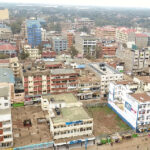Murang’a County, nestled in the heart of Kenya’s Central region, is a vibrant hub of commerce, agriculture, and community life. With 8 sub-counties and 35 electoral wards, this county offers a wealth of opportunities for business professionals looking to tap into its growing economy. For Kenyan entrepreneurs, investors, and corporate leaders, understanding the layout of Murang’a’s wards is key to unlocking its potential—whether you’re eyeing agricultural ventures, retail expansion, or service delivery.
In this detailed guide, we’ll list all 35 wards across Murang’a’s seven constituencies, explore their economic significance, and provide actionable insights for businesses aiming to thrive in 2025. From the bustling urban center of Township Ward to the fertile fields of Kangari, Murang’a’s diversity is its strength. Let’s dive into the wards, their unique attributes, and how they can fuel your next big move.
Murang’a County: A Business Powerhouse in Central Kenya
Murang’a County spans 2,558 square kilometers and is home to over 1.05 million people (2019 Kenya Census), making it the 14th most populous county in Kenya. Bordered by Nyeri to the north, Kiambu to the south, and Kirinyaga to the east, it’s strategically positioned just 85 kilometers from Nairobi. Led by Governor Irungu Kang’ata, the county is driving transformation through agriculture, infrastructure, and youth empowerment programs like the Murang’a Youth Service.
Agriculture dominates here, contributing 70% to the local economy. Tea, coffee, dairy, and horticulture are the big players, with the Murang’a County Creameries leading in milk value addition. The county’s 8 sub-counties—Gatanga, Kandara, Maragwa, Kigumo, Mathioya, Kiharu, Kangema, and Murang’a South—are further divided into 35 wards, each with an elected MCA shaping local development. For businesses, these wards are micro-markets ripe for investment. Here’s the full list, broken down by constituency.
Full List of Wards in Murang’a County by Constituency
Murang’a’s 35 wards are grouped under seven constituencies, each with distinct economic drivers. Below, we detail every ward and spotlight their business potential.
Gatanga Constituency
Gatanga, one of Murang’a’s most populous sub-counties with 187,989 residents (2019 census), includes 6 wards known for agriculture and proximity to Kiambu.
- Ithanga Ward
- Snapshot: Rural, with tea and subsistence farming.
- Business Potential: Farm input supply or small-scale agro-processing.
- Kakuzi/Mitubiri Ward
- Snapshot: Home to pineapple and mango farms, near Thika.
- Business Potential: Fruit processing or logistics for export markets.
- Mugumo-ini Ward
- Snapshot: Agricultural with growing residential pockets.
- Business Potential: Retail outlets or affordable housing projects.
- Kihumbu-ini Ward
- Snapshot: Tea and coffee farming hub.
- Business Potential: Tea value addition or cooperative partnerships.
- Gatanga Ward
- Snapshot: Central ward with trade and farming.
- Business Potential: Microfinance or consumer goods distribution.
- Kariara Ward(Note: Often listed under Gatanga)
- Snapshot: Mixed farming and small markets.
- Business Potential: Transport services or farm machinery rentals.
Kandara Constituency
Kandara, with a population of 156,663, features 6 wards blending rural agriculture with emerging trade centers.
- Ng’araria Ward
- Snapshot: Tea and horticulture stronghold.
- Business Potential: Export-focused agribusiness or irrigation tech.
- Muruka Ward
- Snapshot: Farming with community markets.
- Business Potential: Retail expansion or solar energy solutions.
- Kangundu-ini Ward
- Snapshot: Rural with tea and dairy focus.
- Business Potential: Dairy processing or farm cooperatives.
- Gaichanjiru Ward
- Snapshot: Agricultural with residential growth.
- Business Potential: Real estate or FMCG supply.
- Ithiru Ward
- Snapshot: Tea and subsistence farming.
- Business Potential: Agri-tech tools or seed distribution.
- Ruchu Ward
- Snapshot: Farming with small trade hubs.
- Business Potential: Mobile banking or rural retail.
Maragwa Constituency
Maragwa, population 171,157, hosts 6 wards centered on agriculture and local commerce.
- Kimorori/Wempa Ward
- Snapshot: Farming with trade along Murang’a-Thika road.
- Business Potential: Logistics or consumer goods outlets.
- Makuyu Ward
- Snapshot: Horticulture and pineapple production.
- Business Potential: Processing plants or export trade.
- Kambiti Ward
- Snapshot: Rural with tea and coffee.
- Business Potential: Cooperative financing or farm inputs.
- Kamahuha Ward
- Snapshot: Agricultural with small markets.
- Business Potential: Retail or transport services.
- Ichagaki Ward
- Snapshot: Farming and community-driven economy.
- Business Potential: Micro-enterprise support or solar products.
- Nginda Ward
- Snapshot: Tea and dairy hub near Maragua town.
- Business Potential: Dairy value addition or trade services.
Kigumo Constituency
Kigumo, with 133,365 residents, has 5 wards thriving on tea and coffee production.
- Kahumbu Ward
- Snapshot: Rural tea farming area.
- Business Potential: Tea processing or farm machinery.
- Muthithi Ward
- Snapshot: Agricultural with small trade centers.
- Business Potential: Retail or agribusiness startups.
- Kigumo Ward
- Snapshot: Central ward with tea and commerce.
- Business Potential: Financial services or trade hubs.
- Kangari Ward
- Snapshot: Tea and dairy farming hotspot.
- Business Potential: Milk processing or farm inputs.
- Kinyona Ward
- Snapshot: Rural with tea and coffee.
- Business Potential: Cooperative ventures or renewable energy.
Mathioya Constituency
Mathioya, population 91,338, includes 3 wards focused on tea and rural development.
- Gitugi Ward
- Snapshot: Tea farming with small markets.
- Business Potential: Tea value addition or rural retail.
- Kiru Ward
- Snapshot: Agricultural with community focus.
- Business Potential: Farm supplies or microfinance.
- Kamacharia Ward
- Snapshot: Tea and coffee rural hub.
- Business Potential: Processing units or transport links.
Kiharu Constituency
Kiharu, the most populous at 181,076, features 6 wards including Murang’a town.
- Wangu Ward
- Snapshot: Rural with tea and dairy.
- Business Potential: Dairy processing or farm tech.
- Mugoiri Ward
- Snapshot: Farming with residential growth.
- Business Potential: Housing or consumer goods.
- Mbiri Ward
- Snapshot: Agricultural with small trade.
- Business Potential: Retail or logistics services.
- Township Ward
- Snapshot: Urban center of Murang’a town.
- Business Potential: Retail, B2B services, or tech hubs.
- Murarandia Ward
- Snapshot: Farming with trade near town.
- Business Potential: Distribution or financial services.
- Gaturi Ward
- Snapshot: Tea and coffee rural area.
- Business Potential: Agro-processing or farm inputs.
Kangema Constituency
Kangema, with 76,988 residents, has 3 wards rooted in tea production.
- Kanyenya-ini Ward
- Snapshot: Tea farming hub.
- Business Potential: Tea processing or export trade.
- Muguru Ward
- Snapshot: Rural with tea and coffee.
- Business Potential: Farm supplies or cooperatives.
- Rwathia Ward
- Snapshot: Agricultural with small markets.
- Business Potential: Retail or renewable energy solutions.
Economic Drivers of Murang’a’s Wards
Murang’a’s wards collectively power a KSh 100 billion+ economy (county estimates), with agriculture at the core. Tea exports from wards like Kangari and Kanyenya-ini contribute KSh 15 billion annually, while dairy production—boosted by the Murang’a County Creameries—adds KSh 5 billion. Township Ward anchors urban commerce, with retail and services growing 10% yearly (county data). The county’s 620,929 registered voters (IEBC 2022) signal a sizable consumer base.
Key stats:
- Tea Production: Over 50 million kg annually, per Kenya Tea Development Agency.
- Dairy Output: 200 million liters of milk yearly, with value addition rising.
- Population Density: 413 people per square kilometer, driving demand for goods and services.
For businesses, this mix of rural productivity and urban growth is a goldmine.
Business Opportunities Across Murang’a’s Wards
Murang’a’s wards offer tailored prospects for 2025. Here’s how to tap in:
Agribusiness and Value Addition
- Target Wards: Kangari, Kanyenya-ini, Ng’araria, Wangu.
- Opportunities: Set up tea or dairy processing plants; supply farm inputs.
- Why: Tea and milk production exceeds local processing capacity by 20%.
Retail and Consumer Markets
- Target Wards: Township, Makuyu, Murarandia, Kigumo.
- Opportunities: Open retail stores or distribute FMCG; offer solar products.
- Why: Urban wards see 15% annual consumer spending growth.
Logistics and Transport
- Target Wards: Kakuzi/Mitubiri, Kimorori/Wempa, Mugumo-ini.
- Opportunities: Provide farm-to-market transport or cold storage.
- Why: Rural wards lose 10% of produce to poor logistics (county reports).
Financial and Digital Services
- Target Wards: Township, Kerugoya, Kihumbu-ini, Nginda.
- Opportunities: Expand mobile banking or e-commerce platforms.
- Why: Digital transactions in Saccos jumped 15% in 2023 (SASRA).
Challenges and Fresh Perspectives
Murang’a’s wards face hurdles that savvy businesses can turn into opportunities:
- Road Networks: Rural wards like Gitugi and Rwathia need upgrades—logistics firms can fill the gap.
- Digital Access: Township thrives online, but Kinyona lags—tech providers can bridge this divide.
- Youth Employment: With 40% of the population under 25, skills training or tech startups could tap this talent pool.
A fresh angle: Murang’a’s wards are a testing ground for circular economies. Pair Township’s urban demand with Kangari’s dairy supply, or link Makuyu’s pineapples to export markets via Kakuzi/Mitubiri’s proximity to Thika. The county’s Murang’a University of Technology (MUT) churns out 1,000+ graduates yearly—ideal for tech-driven ventures.
How Businesses Can Engage with Murang’a’s Wards
Ready to act? Here’s a practical roadmap:
- Pinpoint Your Ward: Match your business—tea in Kangema, retail in Township—to local strengths.
- Visit and Network: Meet MCAs or traders in Kigumo or Nginda for real-time insights.
- Leverage County Plans: The KSh 8 billion 2024/2025 budget targets agriculture—align your strategy.
- Partner Locally: Team up with Saccos or farmer groups for credibility and reach.
- Go Digital: Even rural wards use M-Pesa—offer online solutions to scale fast.





